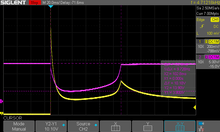Foldback (power supply design)
Foldback is a current limiting feature (a type of overload protection) of power supplies and power amplifiers. When the load attempts to draw overcurrent from the supply, foldback reduces both the output voltage and current to well below the normal operating limits. Under a short circuit, where the output voltage has reduced to zero, the current is typically limited to a small fraction of the maximum current.


The prime purpose of foldback current limiting in linear power supplies is to keep the output transistor within its safe power dissipation limit. With a linear voltage regulator, the output voltage Vout and output current Iout are maintained by simply dissipating away the surplus of input voltage Vin:
Under overload conditions the output voltage falls and so the difference Vin - Vout becomes larger, thus increasing dissipation. For a simple current limit, safely handling the worst-case scenario (a short circuit) would therefore require a much larger heatsink and output transistor than would be required under normal operating conditions. Foldback partially solves this, helping to keep the normal-rated output transistor within its safe operating area under fault and overload conditions. Foldback also significantly reduces the power dissipation in the load in fault conditions, which can reduce the risks of fire and heat damage.[1]
Many power supplies employ constant current limiting protection; foldback goes one step further by reducing the output current limit linearly as output voltage decreases. However it adds complexity to the power supply and can trigger "lockout" conditions with non-ohmic devices that draw a constant current independent of supply voltage (such as op-amps). A foldback current limiter may also employ a transient delay to both avoid lockout and limit localized heating at the short circuit. A switched-mode power supply operating at the current limit with the output short circuited does not have increased power dissipation in the power transistor(s), so foldback current limiting is an application feature only rather than one that also prevents a load fault from also destroying the power supply. The safety benefit of reducing the power delivered to a short circuit in the load is proportional to the operating current limit. Foldback current limiting is most likely to be found in a switchmode power supply when it is a component in a product that is independently certified to meet regional safety standards. [2]

References
- Paul Horowitz, Winfield Hill, The Art of Electronics Second Edition, Cambridge University Press, 1989 ISBN 0-521-37095-7, p.316
- Keith H. Billings (1999). Switchmode power supply handbook. McGraw-Hill Professional. p. 1.113. ISBN 978-0-07-006719-6.